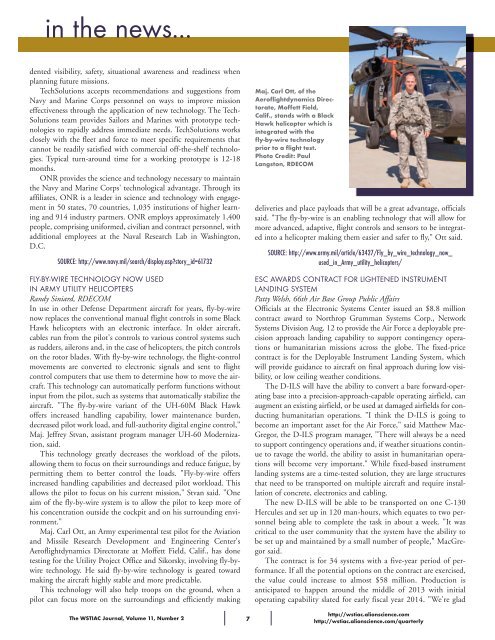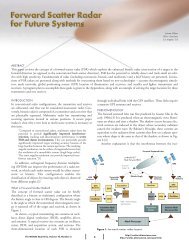Comparing Blast Pressure Variations of Lead Primers - Weapon ...
Comparing Blast Pressure Variations of Lead Primers - Weapon ...
Comparing Blast Pressure Variations of Lead Primers - Weapon ...
You also want an ePaper? Increase the reach of your titles
YUMPU automatically turns print PDFs into web optimized ePapers that Google loves.
in the news...<br />
dented visibility, safety, situational awareness and readiness when<br />
planning future missions.<br />
TechSolutions accepts recommendations and suggestions from<br />
Navy and Marine Corps personnel on ways to improve mission<br />
effectiveness through the application <strong>of</strong> new technology. The Tech-<br />
Solutions team provides Sailors and Marines with prototype technologies<br />
to rapidly address immediate needs. TechSolutions works<br />
closely with the fleet and force to meet specific requirements that<br />
cannot be readily satisfied with commercial <strong>of</strong>f-the-shelf technologies.<br />
Typical turn-around time for a working prototype is 12-18<br />
months.<br />
ONR provides the science and technology necessary to maintain<br />
the Navy and Marine Corps' technological advantage. Through its<br />
affiliates, ONR is a leader in science and technology with engagement<br />
in 50 states, 70 countries, 1,035 institutions <strong>of</strong> higher learning<br />
and 914 industry partners. ONR employs approximately 1,400<br />
people, comprising uniformed, civilian and contract personnel, with<br />
additional employees at the Naval Research Lab in Washington,<br />
D.C.<br />
SOURCE: http://www.navy.mil/search/display.asp?story_id=61732<br />
FLY-BY-WIRE TECHNOLOGY NOW USED<br />
IN ARMY UTILITY HELICOPTERS<br />
Randy Siniard, RDECOM<br />
In use in other Defense Department aircraft for years, fly-by-wire<br />
now replaces the conventional manual flight controls in some Black<br />
Hawk helicopters with an electronic interface. In older aircraft,<br />
cables run from the pilot's controls to various control systems such<br />
as rudders, ailerons and, in the case <strong>of</strong> helicopters, the pitch controls<br />
on the rotor blades. With fly-by-wire technology, the flight-control<br />
movements are converted to electronic signals and sent to flight<br />
control computers that use them to determine how to move the aircraft.<br />
This technology can automatically perform functions without<br />
input from the pilot, such as systems that automatically stabilize the<br />
aircraft. "The fly-by-wire variant <strong>of</strong> the UH-60M Black Hawk<br />
<strong>of</strong>fers increased handling capability, lower maintenance burden,<br />
decreased pilot work load, and full-authority digital engine control,"<br />
Maj. Jeffrey Stvan, assistant program manager UH-60 Modernization,<br />
said.<br />
This technology greatly decreases the workload <strong>of</strong> the pilots,<br />
allowing them to focus on their surroundings and reduce fatigue, by<br />
permitting them to better control the loads. "Fly-by-wire <strong>of</strong>fers<br />
increased handling capabilities and decreased pilot workload. This<br />
allows the pilot to focus on his current mission," Stvan said. "One<br />
aim <strong>of</strong> the fly-by-wire system is to allow the pilot to keep more <strong>of</strong><br />
his concentration outside the cockpit and on his surrounding environment."<br />
Maj. Carl Ott, an Army experimental test pilot for the Aviation<br />
and Missile Research Development and Engineering Center's<br />
Aer<strong>of</strong>lightdynamics Directorate at M<strong>of</strong>fett Field, Calif., has done<br />
testing for the Utility Project Office and Sikorsky, involving fly-bywire<br />
technology. He said fly-by-wire technology is geared toward<br />
making the aircraft highly stable and more predictable.<br />
This technology will also help troops on the ground, when a<br />
pilot can focus more on the surroundings and efficiently making<br />
The WSTIAC Journal, Volume 11, Number 2 7<br />
Maj. Carl Ott, <strong>of</strong> the<br />
Aer<strong>of</strong>lightdynamics Directorate,<br />
M<strong>of</strong>fett Field,<br />
Calif., stands with a Black<br />
Hawk helicopter which is<br />
integrated with the<br />
fly-by-wire technology<br />
prior to a flight test.<br />
Photo Credit: Paul<br />
Langston, RDECOM<br />
deliveries and place payloads that will be a great advantage, <strong>of</strong>ficials<br />
said. "The fly-by-wire is an enabling technology that will allow for<br />
more advanced, adaptive, flight controls and sensors to be integrated<br />
into a helicopter making them easier and safer to fly," Ott said.<br />
SOURCE: http://www.army.mil/article/63427/Fly_by_wire_technology_now_<br />
used_in_Army_utility_helicopters/<br />
ESC AWARDS CONTRACT FOR LIGHTENED INSTRUMENT<br />
LANDING SYSTEM<br />
Patty Welsh, 66th Air Base Group Public Affairs<br />
Officials at the Electronic Systems Center issued an $8.8 million<br />
contract award to Northrop Grumman Systems Corp., Network<br />
Systems Division Aug. 12 to provide the Air Force a deployable precision<br />
approach landing capability to support contingency operations<br />
or humanitarian missions across the globe. The fixed-price<br />
contract is for the Deployable Instrument Landing System, which<br />
will provide guidance to aircraft on final approach during low visibility,<br />
or low ceiling weather conditions.<br />
The D-ILS will have the ability to convert a bare forward-operating<br />
base into a precision-approach-capable operating airfield, can<br />
augment an existing airfield, or be used at damaged airfields for conducting<br />
humanitarian operations. "I think the D-ILS is going to<br />
become an important asset for the Air Force," said Matthew Mac-<br />
Gregor, the D-ILS program manager, "There will always be a need<br />
to support contingency operations and, if weather situations continue<br />
to ravage the world, the ability to assist in humanitarian operations<br />
will become very important." While fixed-based instrument<br />
landing systems are a time-tested solution, they are large structures<br />
that need to be transported on multiple aircraft and require installation<br />
<strong>of</strong> concrete, electronics and cabling.<br />
The new D-ILS will be able to be transported on one C-130<br />
Hercules and set up in 120 man-hours, which equates to two personnel<br />
being able to complete the task in about a week. "It was<br />
critical to the user community that the system have the ability to<br />
be set up and maintained by a small number <strong>of</strong> people," MacGregor<br />
said.<br />
The contract is for 34 systems with a five-year period <strong>of</strong> performance.<br />
If all the potential options on the contract are exercised,<br />
the value could increase to almost $58 million. Production is<br />
anticipated to happen around the middle <strong>of</strong> 2013 with initial<br />
operating capability slated for early fiscal year 2014. "We're glad<br />
http://wstiac.alionscience.com<br />
http://wstiac.alionscience.com/quarterly




